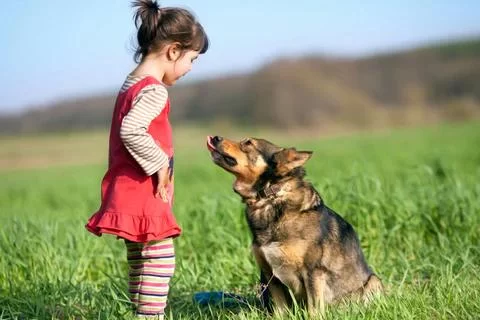- Importance of Training Dogs to Be Calm Around Kids
- Key Steps to Train a Dog for Calm Behavior Near Children
- Practical Tips for Socializing Dogs with Kids
- Real-Life Story: How Training Made a Difference
- Getting Professional Help from Hidden Brook Veterinary
1. Importance of Training Dogs to Be Calm Around Kids
Families with children often worry about how their dog will behave around the little ones. Teaching your dog to remain calm around kids is essential for creating a safe and enjoyable home environment for everyone. Dogs can be naturally excitable or protective, and without proper training, their behavior might unintentionally cause stress or harm to children.
Understanding how to train a dog to be calm around kids goes beyond simple obedience. It involves building trust, fostering positive associations, and ensuring the dog feels secure when children are present. This foundation helps prevent anxiety, jumping, or overexcitement that can sometimes lead to accidents or fearful reactions.
1.1 Why Calm Behavior Matters for Both Dogs and Kids
Calm dogs are easier to manage and interact with, reducing risks of nipping or unintentional roughness. For children, a calm dog creates a comfortable space where they can play, learn, and bond without fear. Teaching calmness supports healthy relationships and lifelong positive experiences between pets and kids.
2. Key Steps to Train a Dog for Calm Behavior Near Children
Training a dog to stay calm around kids requires patience, consistency, and positive reinforcement. Here are important steps to guide this process:
2.1 Establish Basic Obedience Commands
Before introducing children, your dog should reliably respond to commands like “sit,” “stay,” “leave it,” and “come.” These commands provide control in stimulating environments and help the dog focus.
2.2 Gradual Exposure to Children in Controlled Settings
Start by letting your dog observe children from a distance, rewarding calm behavior with treats and praise. Slowly decrease the distance as the dog shows comfort and composure. This stepwise approach prevents overwhelming the dog and builds positive associations.
2.3 Reinforce Calmness with Positive Reinforcement
When your dog remains relaxed around kids, immediately reward them with treats or affection. This encourages the dog to repeat calm behaviors. Avoid punishing anxious or excited responses as it can increase stress and confusion.
2.4 Create Safe Spaces for Your Dog
Providing a quiet, comfortable retreat allows your dog to take breaks when interactions become too intense. Teaching children to respect these spaces also supports the dog’s emotional well-being.
3. Practical Tips for Socializing Dogs with Kids
Beyond training commands, teaching both dogs and children respectful interaction is vital. Here are some practical tips:
3.1 Educate Children on Proper Dog Handling
Children should learn to approach dogs calmly, avoid sudden movements or loud noises, and never disturb a dog while eating or resting. Safe petting techniques and body language awareness help prevent accidental scares or bites.
3.2 Use Playtime as an Opportunity for Calm Engagement
Structured play with toys or gentle games can promote calm excitement. Monitoring play ensures it stays positive and prevents overstimulation.
3.3 Consistency Across Family Members
Everyone in the household should follow the same training cues and behavior expectations to avoid confusing the dog. Consistency builds clear communication and reinforces calm behavior effectively.
4. Real-Life Story: How Training Made a Difference
Take the example of Luna, a young golden retriever adopted by a family with two energetic children. Initially, Luna was overly excited, jumping on the kids and barking loudly. The family worked closely with Hidden Brook Veterinary’s training experts who advised a gradual socialization plan focused on rewarding calm behavior and teaching the children respectful interaction.
Over several weeks, Luna learned to greet the children calmly, even during playtime, and the kids grew more confident in their interactions. This transformation not only improved the dog’s behavior but also deepened the family bond, demonstrating the power of effective training.
5. Getting Professional Help from Hidden Brook Veterinary
Sometimes training a dog to be calm around kids requires professional guidance. Hidden Brook Veterinary offers personalized consultations and training support tailored to your dog’s temperament and family dynamics. Their experienced team combines veterinary knowledge with behavioral expertise to craft safe and effective training plans.
If you are looking for advice on how to train a dog to be calm around kids or need specialized training products, Hidden Brook Veterinary is a trusted resource. Their commitment to pet health and well-being ensures your dog and children enjoy a harmonious, happy relationship for years to come.










